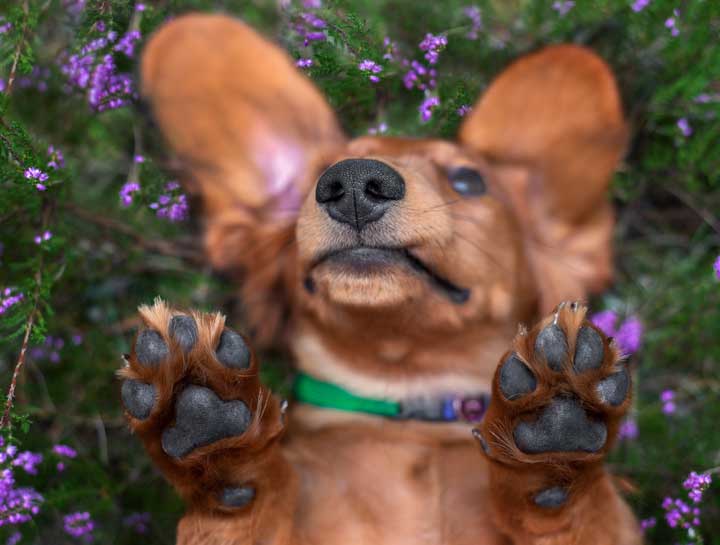Dog Paw Injury? How to Care for the Wound

In this article on tending to a dog paw injury, you’ll learn:
(1) The signs of a dog paw injury
(2) When to call a vet
(3) What you can do at home
(4) What you can do when an injury occurs while hiking
(5) The signs of an infection
(6) When stitches are needed
(7) How to help your dog recover
If you live in Colorado, a dog paw injury can happen anytime
In the 15+ years we’ve run our veterinary clinic, we’ve seen dog paw injuries year-round.
- When it’s warm, we see dog cuts from metal lawn edging and barbed wire on old ranch properties.
- In the winter, our veterinarians often see dog paw wounds caused by ice on sidewalks and roads. (Ice can be as sharp as glass!)
Signs of a dog paw injury (and when to call a vet)
The main thing to look for is bleeding or limping.
Dogs have arteries in their paw pads.
Excessive or ongoing bleeding can be a sign that an artery has been hit.
It’s time to visit veterinarians, like ours, if:
- Your dog’s paw won’t stop bleeding.
- You look at your dog’s paw and think to yourself, “If this were me, I’d go to the doctor.”
- Or, you don’t take action and your dog doesn’t seem to be getting better.
The good news is that not all dog paw injuries are serious.
Many times, a little bit of your dog’s paw pad will peel off.
Or, your dog will get a superficial abrasion or rash from gravel — almost like a rug burn or a scraped arm.
We can apply pressure, clean the wound and treat it with a special antibiotic ointment.
It should heal properly.
We just want to make sure the dog cut is properly cleaned, and your pup doesn’t need stitches.

What you can do at home
The best thing you can do for a dog paw injury is to bandage the wound.
If you have first aid supplies available, we suggest covering the wound with a gauze pad or a Telfa pad and then wrapping it with an Ace bandage.
You also can wrap the wound with a towel.
We don’t recommend trying to clean the wound yourself. Sometimes, this will make it worse.
Related article: Two drugs you shouldn’t give a dog in pain
If the injury happens early in the day, it doesn’t look to be serious and you’ve bandaged the wound, the next step is to call our veterinary clinic.
You can make an appointment to drop your dog off.
Or, you can make an appointment for later in the day, so you can go to work.
What you can do for a wound on the trail
If you find yourself out on the trail, here’s what to do for a dog wound or a bleeding paw when hiking.

Signs of infection in a dog paw injury
Infections can be serious and need attention.
Here are signs to watch for:
- Your dog’s paw pads are puffy and red.
- Your dog may not want to walk on his or her paw.
- Your dog may be running a little fever — and yes, your dog may feel warmer to you.
- You may notice your dog is panting more than usual. Excessive panting can be related to pain.
- When you go to look at your dog’s paw, your pup is not as cooperative as usual. If Rover normally lets you touch his paw and he pulls away, something hurts!

When stitches are needed for a dog paw injury
Our veterinarians may need to stitch your dog’s paw if:
- The wound is jagged.
- It’s a clean cut, but it’s fairly deep and long.
- The wound is bleeding a lot, or it won’t stop bleeding.
The positive thing about stitches is they can help your dog’s paw heal faster.
You won’t be dealing with a dog paw injury for weeks.
And your furry friend will be comfortable much sooner.
It’s common for dogs in Castle Rock to get paw injuries from the barbed wire while walking on old ranch lands.
Puncture wounds don’t always require stitches.
When you bring your dog in, our vets will make sure an artery hasn’t been hit, and the wound isn’t infected.
If stitches aren’t required, we’ll properly clean and bandage it.

Helping your dog recover from a dog paw injury
After you visit the vet, there’s usually very little you have to do at home.
We’ll ask you to monitor your dog for any unusual behaviors that may indicate an issue.
You’ll also need to keep your eye on your dog to make sure he doesn’t bother the wound site.
(Some dogs are great at leaving their wounds alone. Others… not so much.)
If there’s any chance your dog will try to remove the bandage, your pup will need to wear a head cone.
In cases with more extreme wounds (for example, torn claws)…
We’ll place your dog on restricted activity for a little while.
We also may need to change the bandages.
Our veterinarians will walk you through everything, so you know exactly what to expect.
